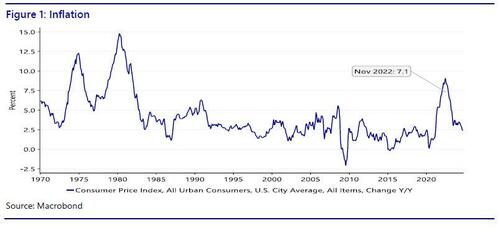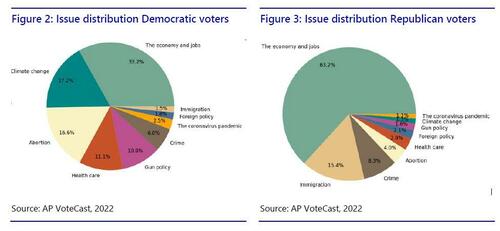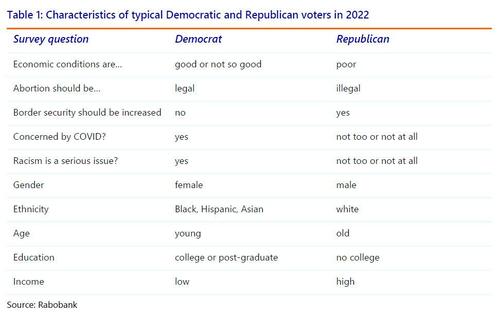What Drives US Voters
By Philip Marey, Senior US Strategist at Rabobank (also available in pdf format)
Summary
-
We analyze a 2022 survey from AP VoteCast to understand what drives US voters. We find that voters who judged economic conditions as “poor”, were more likely to vote for a Republican candidate in the Senate or the House of Representatives, punishing the Biden-Harris administration. In contrast, those who considered economic conditions to be “good” were more likely to vote Democrat. However, voters who judged economic conditions as “not so good” were also more likely to favor a Democrat, suggesting that Biden did not get all of the blame for the disappointing economy or that voters made a trade-off between the economy and other issues.
-
On social policy issues, voters are more likely to vote for a Republican if they think that abortion should be illegal in all or most cases, if they think that the racism issue is not too or not at all serious, if they were not too or not at all concerned about COVID and if they strongly favor increased border security.
-
We also found that demographic characteristics determined US voter behavior. Men are more likely to vote Republican. In contrast, women and non-binary people are more likely to vote Democrat. The same is true for Black, Latino and Asian people. White people are more likely to vote Republican. People with a higher income are more likely to vote Republican, but – at a given income level – college graduates and people with a postgraduate degree are more likely to vote Democrat.
-
While this confirms several stereotypes, we also find some more nuanced results. For example, the probability of voting Republican increases with age until it peaks at the 50-64 segment, then it falls back a little. Moreover, if we take a closer look at the Hispanic vote, we find that Cuban Americans are more likely to vote Republican. Finally, it should be noted that the regression results imply that Black men are less likely to vote Democrat than Black women.
-
We also find that pop culture affects voter behavior, with people having a favorable view of Taylor Swift more likely to vote Democrat – even within their age cohort– and those with an unfavorable view of her more likely to vote Republican.
-
For the 2024 elections, our results suggest that the economy is a drag on the Harris campaign, but there are opportunities to offset this through social policy issues such as abortion. What’s more, our results show that in demographic terms Kamala Harris more closely resembles the typical Democratic voter than Joe Biden, which could help explain the increase in enthusiasm among Democratic voters after she replaced him at the top of the ticket. However, our results also explain why Harris has difficulty convincing Black men to vote for her: they are less likely to vote Democrat than Black women more generally, even if she is not on the ticket.
Introduction
The 2022 US midterm elections presented a complex political landscape. This report uses data from the AP VoteCast survey to delve into the various factors that shaped voter behavior and electoral outcomes, focusing on three key areas: the impact of economic anxieties on voting behavior, the changes in policies on abortion and immigration, and the demographics of American voters. The 2022 midterms occurred against a backdrop of significant economic uncertainty, with inflation emerging as a dominant concern among voters. As inflation hit a 40-year high of 9.1% in June 2022, Americans expressed growing anxiety about their financial wellbeing, despite a low unemployment rate of 3.6%. By November 2022, inflation had started to fall, but was still very high at 7.1%.
The 2022 midterms also demonstrated the rapid evolution of voter priorities. Just two years earlier, during the height of the pandemic, healthcare and public health concerns dominated the political discourse. By 2022, these issues had taken a backseat to inflation. However, despite the changes in priorities compared to the 2020 elections, voters were still concerned with non-economic issues. Figure 2 and 3 show the responses of voters to “Which one of the following would you say is the single most important issue for you?”
The economy was the main concern among both Democrats and Republicans, with 33.2% and 63.2% of respondents choosing it respectively. However, for Democrats climate change, abortion and healthcare followed closely. For Republicans, at some distance, immigration and crime were mentioned most often.
Regarding abortion, The Supreme Court’s decision to overturn Roe v. Wade in Dobbs v. Jackson Women’s Health Organization had a significant impact on the 2022 midterm elections. For about a quarter of voters, the Court’s decision was the single most important factor in their midterm vote. This figure increased to more than 3 in 10 among groups traditionally aligned with prochoice positions: Democratic voters, younger women, and first-time voters. These voters predominantly supported Democratic candidates. The impact was particularly pronounced among women of color. Majorities of Black and Hispanic women reported that the Supreme Court decision influenced their voting behavior. Finally, a key issue for Republican voters in 2022 was immigration, because of a surge in the number of migrant apprehensions at the southern border. Democrats, however, ranked immigration as their last concern.
The data set from the 2022 midterms offers valuable insights into US voter behavior. It reveals that while economic concerns were at the forefront of voter priorities, these were not the only factors driving electoral decisions. The economic anxieties that dominated the political discourse led to a Republican majority in the House. However, the data also underscores the continued significance of non-economic issues, such as abortion and immigration, in shaping voter behavior. The Supreme Court’s decision to overturn Roe v. Wade emerged as a pivotal factor, underscoring the powerful role of social issues in mobilizing the electorate.
Data and model
Our analysis is grounded in a comprehensive dataset primarily sourced from AP VoteCast, a nationwide survey conducted after midterm and general elections in the US comprising more than 100 thousand respondents. This data provides direct insights into the demographics, sentiments, and perceptions on various economic and non-economic topics of individual voters. AP VoteCast, initiated in 2018, combines interviews with randomly sampled registered voters from state voter files and self-identified registered voters from NORC’s AmeriSpeak® panel and nonprobability online panels.
To examine the relationships between voters’ attitudes and their candidate preferences, we employ a logistic regression model. The regression analysis of the data at the individual level helps us understand how these various factors interact and influence voting behavior. We can analyze the impact of economic factors and social policy issues, given the demographic characteristics and vice versa. This means that we can isolate the pure effects of economic factors, social policy issues and demographic characteristics on voter behavior at the micro level, rather than effects at the macro level that are distorted by the composition of the sample.
Empirical results
Our regression results can be described as follows. In 2022, voters who judged economic conditions as “poor”, were more likely to vote for a Republican candidate in the Senate or the House of Representatives. This is a plausible result since the Democrats (the Biden-Harris administration) were in charge of economic policy. In contrast, those who considered economic conditions to be “good” were more likely to vote Democrat. Interestingly, also voters who judged economic conditions as “not so good” favored a Democrat. So some voters were willing to forgive Biden or thought that he was not (fully) to blame for the economic conditions. We should not forget that high inflation in 2021 and 2022 was not restricted to the US, although the empirical evidence suggests that excessive fiscal policy has made it worse. Also, some voters could be making a trade-off between the economy and other issues. For example, if you oppose making abortion illegal, you may be willing to tolerate some economic adversity from the party that is pro-choice.
Now let’s turn to these social policy issues. Voters who thought that abortion should be illegal in all or most cases were more likely to vote Republican. In contrast, voters who though that abortion should be legal in most cases were more likely to support a Democratic candidate. Voters who were not too or not at all concerned about COVID were more likely to vote Republican, while voters who were somewhat or very concerned favored the Democrats. Compared to voters who strongly favored increased border security, those who only somewhat favored this or opposed this were more likely to vote Democrat. Those who thought the racism issue was not too or not at all serious were more likely to vote Republican compared to those who thought it was somewhat or very serious.
These questions were all about political issues, but we also found that demographic characteristics – even after correcting for economic and social policy issues – determined voter behavior. In particular, women and non-binary people were more likely to vote Democrat. The same is true of Black, Latino and Asian people. Age also matters, as people above 30 are more likely to vote Republican. This probability increases with age until it peaks at the 50-64 segment. People of 65 and older are also more likely to vote Republican, but not as much as the cohort below. If we look at education, we find that college graduates and people with a postgraduate degree are more likely to vote Democrat. In contrast, people with a higher income are more likely to vote Republican. This may seem contradictory because people with a higher education tend to have a higher income. However, our regression allows us to identify the effects of education given a certain level of income and vice versa. So if two persons with the same education differ only in their income level, then the one with the higher income is more likely to vote Republican. And if two people with the same income level differ only in their level of education, then the higher educated person is more likely to vote Democrat.
To summarize, the Republican voter in 2022 could be characterized as an older white male with a higher income but no college degree who judged economic conditions as poor, who thought that abortion should be illegal, strongly favored increased border security, was not too or not at all concerned by COVID and thought that the racism issue was not too or not at all serious. In contrast, a Democratic voter was typically a younger college-educated woman of color with a lower income who judged economic conditions as good or not so good, who thought that abortion should be legal, did not strongly favor increased border security and was concerned about COVID and racism.
While table 1 may confirm several stereotypes, the regression results show some nuances. Take age for example: the tendency to vote Republican rises with age, but falls back a little for people of 65 and older. We have also taken a closer look at ethnicity and found that not all Hispanic groups exhibit the same voting behavior. In particular, Cuban Americans are more likely to vote Republican than Democrat. This can likely be attributed to the tougher foreign policy stance of the GOP regarding Cuba. Hispanics from all other countries of origin are more likely to vote Democrat. Finally, since the regression isolates the effect of being Black from being a man, the results explain why Kamala Harris is currently having trouble getting support from Black men. Note that these regression results are based on the 2022 midterms, so well before Kamala Harris rose to the top of the Democratic ticket. It shows that Black men being less likely to vote Democrat than Black women is not specific to presidential elections. While former president Obama recently suggested that Black men “just aren’t feeling the idea of having a woman as president”, Democrats should probably better ask themselves why one of their key demographics has been drifting toward the GOP for some time now. The Democrats’ “Opportunity agenda for Black men” that they are now suddenly rolling out may be too little too late for this year’s election.
The Taylor Swift effect
The 2022 midterms also highlight an intriguing connection between pop culture and political preferences. In 2020 Taylor Swift released the song “Only the young” – a political anthem aimed to encourage young adults to “speak up and stand for what is right.” It made references to the surprise victory of Donald Trump in 2016 and how the young voters were outnumbered. Swift’s influence reflects broader trends in youth political engagement. Her public support for Democratic candidates, particularly her advocacy for LGBTQ+ rights, gender equality, and opposition to systemic racism, aligns with issues that resonate strongly with younger voters. This alignment is significant given that Swift’s fan base largely consists of Millennials and Gen Z, demographics that statistically lean more liberal and are generally more receptive to social justice movements. The “Taylor Swift effect” thus serves as a microcosm of larger cultural shifts influencing political engagement among younger voters.
This raises two interesting questions: are Taylor Swift fans more likely to vote Democrat, and if so, is this simply a reflection of their age cohort being more liberal, or are “Swifties” (Taylor Swift fans) actually more likely to vote Democrat than other people with the same demographic characteristics? We find that people with a “very favorable” or “somewhat favorable” view of Taylor Swift are more likely to vote Democrat. In contrast, those with a “somewhat unfavorable” or “very unfavorable” view of her are more likely to vote Republican. Note that the regression takes into account age, so even within the subset of Millennials and Gen Z those with a favorable view of Taylor Swift are more likely to vote Democrat. In this sense, the “Taylor Swift effect” is real. After the debate between Trump and Harris on September 10, Taylor Swift endorsed Kamala Harris “because she fights for the rights and causes I believe need a warrior to champion them.” Swift’s endorsement could help raise the voter turnout among a demographic that is culturally close to the values of the Democrats.
Conclusion
Our findings reveal that while economic anxieties drove many voters towards Republican candidates in 2022, social issues and demographics provided countervailing forces, contributing to the Democrats’ stronger-than-expected performance. In our midterm preview in 2022, we explained that based on economic performance, Biden’s approval rating and the usual midterm loss for the party occupying the White House, the Republicans should be heading for a landslide victory in the midterms, but that the more modest polling results suggested that other factors, such as abortion, could be leading to Republican underperformance, as it did on Election Day.
For the 2024 elections, our results suggest that the economy is likely a drag on the Harris campaign, but there are opportunities to offset this through social policy issues such as abortion. What’s more, while Kamala Harris may have been picked as Vice-President to balance the 2020 Democratic ticket, our regression results show that she is not just another demographic of the Democratic Party, but she actually gets close to representing the typical Democratic voter. This could help explain the recent enthusiasm among Democratic voters that was absent when Biden was on top of the presidential ticket. This also meant that picking Tim Walz as VP candidate was necessary to balance the ticket and attract swing voters. However, our results also show that Black men have been less likely to vote Democrat than Black women well before Kamala Harris rose to the top of the Democratic ticket. Taking a key demographic for granted could hurt the Democratic Party well beyond the 2024 presidential election.
Tyler Durden
Sun, 11/03/2024 – 19:50




